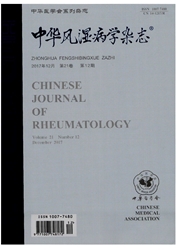

 中文摘要:
中文摘要:
目的 研究免疫纤溶酶获得的抗纤溶酶抗体与其他的抗磷脂综合征相关的自身抗原的交叉反应性,以及抗纤溶酶抗体的致病性。方法 用天然的人纤溶酶免疫小鼠,获得10株抗纤溶酶单克隆抗体.固相酶联免疫吸附试验(ELISA)检测免疫小鼠血清及单抗对纤溶酶、心磷脂、β2糖蛋白Ⅰ、蛋白C、凝血酶的识别,使用部分凝血酶原时间(APTT)检测了单抗对凝血时间的影响。单抗5E9和5C5用于诱导BALB/c小鼠的流产模型.用抗C3b/C3c抗体行免疫组织化学检测活化补体对胎盘的损伤作用。结果 受纤溶酶免疫的小鼠血清与纤溶酶(10/10)、心磷脂(5/10)、β2糖蛋白Ⅰ(7/10)、蛋白C(6/10)和凝血酶(3/10)存在交叉反应性。所有的10株单抗都与纤溶酶反应,各有1株与β2糖蛋白Ⅰ、蛋白C和凝血酶有结合能力,在胎牛血清封闭的心磷脂检测实验中有3株对心磷脂有结合能力。单抗5E9能延长APTT,呈现狼疮抗凝物特性:5C5和5F10能降低纤溶酶的水解活性。在体内实验中,单抗5E9和5C5能增加孕鼠的死胎率,5E9和5C5单抗均能降低小鼠的胎盘和胎鼠的重量,免疫组织化学显示了这两株抗纤溶酶抗体处理后的小鼠胎盘的绒毛膜和蜕膜的间质血管活化的补体C3沉积。结论 纤溶酶是一种新发现的抗磷脂抗体的靶抗原.纤溶酶可能与其他参与凝血和纤溶的分子存在共同抗原表位。导致了抗纤溶酶抗体与β2糖蛋白Ⅰ、蛋白C和凝血酶之间的交叉反应,提示抗纤溶酶抗体的抗磷脂抗体样致病作用是通过补体活化途径依赖的。
 英文摘要:
英文摘要:
Objective To explore whether there are cross reaction between murine anti-plasmin antibodies immunized by human plasmin with other antigens associated with antiphospholipid syndrome and the pathogenic property of anti-plasmin antibodies. Methods Mice were immunized by native human plasmin, and sera from them and ten murine monoclonal antibodies were acquired. The cross-reactivity of poly-and monoclonal anti-plasmin antibodies against beta2 glycoprotein 1, protein C and thrombin were assayed by enzyme linked immunoabsorption method. The influence of monoclonal antibodies on coagulation time was assayed by activated partial thrombosis time (APTT), and inhibitory effect of monoclonal antibody on plasmin was also assayed by thromogenic substrate method. 5E9 and 5C5 were selected to induce abortion in pregnant mice. Immunohistochemistry analysis of placentas was assayed by anti-complement C3b/C3c antibody. Results Among the 10 anti-plasmin antibodies positive sera from mice, 5 were aCL positive in buffer containing 10% fetal bovine serum, 7 of 10 were anti-β2GP1 positive and 6 of them were anti-protein C positive, 3 of them were anti-thrombin positive. In all of the 5 monoclonal anti-plasmin antibodies, only 3 of them could bind to β2-GP1, protein C and thrombin respectively. In function assay, one of them could prolong APTT. Two of them could inhibit amidolytic activity of plasmin. Two mAbs 5E9 and 5C5 were selected to establish the model of murine abortion. It was found that these two mAbs together could reduce the number of fetus, the fetal and placentae weight were significantly decreased in mAbs injection group than those of the control group. Activated C3 deposited around the small vessel wall and deciduas of placentas were detected. Conclusion Plasmin is a target antigen in antiphospholipid syndrome which has been identified recently. Maybe there are cross-reactive epitopes among plasmin, tbrombin/prothrombin, protein C in antiphospholipid syndrome (APS). Autoantibodies that can recognize those antige
 同期刊论文项目
同期刊论文项目
 同项目期刊论文
同项目期刊论文
 期刊信息
期刊信息
